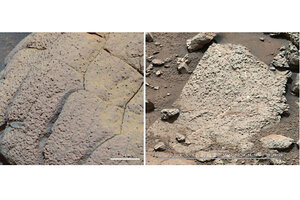Did life on Earth originate on Mars?
Rock samples gathered by NASA's Curiosity Mars rover suggest that the Red Planet could have supported microbial life at about the same time that life first appeared on Earth, meaning that any life on Mars, if there was any, could have predated, and possibly even seeded, life on Earth.

This set of images compares rocks seen by NASA's Opportunity rover and Curiosity rover at two different parts of Mars. On the left is " Wopmay" rock, in Endurance Crater, Meridiani Planum, as studied by the Opportunity rover. On the right are the rocks of the "Sheepbed" unit in Yellowknife Bay, in Gale Crater, as seen by Curiosity. Image released March 12, 2013.
NASA/JPL-Caltech/Cornell/MSSS
The discovery that ancient Mars could have supported microbes raises the tantalizing possibility that life may have evolved on the Red Planet before it took root on Earth.
New observations by NASA's Curiosity rover suggest that microbial life could have survived on Mars in the distant past, when the Red Planet was a warmer and wetter place, scientists announced Tuesday.
It's unclear exactly how long ago Mars' habitability window opened up, researchers said. But the timing may be comparable to that of Earth, where life first appeared around 3.8 billion years ago.
"We're talking about older than 3 billion years ago, and we're probably looking at a situation where, plus or minus a couple hundred million years, it's about the time that we start seeing the first record of life preserved on Earth," Curiosity chief scientist John Grotzinger, of Caltech in Pasadena, said during a press conference Tuesday. [The Search for Life on Mars (Photo Timeline)]
The Curiosity team's conclusions are based on the rover's study of material collected from the interior of a Martian rock. Last month, Curiosity used its hammering drill to bore 2.5 inches (6.4 centimeters) into part of a Red Planet outcrop dubbed "John Klein" — deeper than any Mars robot had ever gone before.
Curiosity's analyses show that the John Klein area was once a benign aqueous environment, such as a neutral-pH lake, researchers said. Further, the rover's instruments detected many of the chemical ingredients necessary for life as we know it, including sulfur, nitrogen, hydrogen, oxygen, phosphorus and carbon.
Mission scientists aren't claiming that life has ever existed on the Red Planet. They have found no signs of Martian microbes, which is no surprise since the car-size Curiosity rover carries no life-detection instruments among its scientific gear.
But the advanced age of the John Klein deposits does open the door to some interesting speculation. If life ever flourished on Mars — a very big if — did it predate life on Earth? And if so, could Earth life trace its lineage back to Mars?
Some microbes are incredibly hardy, after all, and may be able to survive an interplanetary journey after being blasted off their home world by an asteroid impact. And orbital dynamics show that it's much easier for rocks to travel from Mars to Earth than the other way around.
These are questions scientists and laypeople alike will undoubtedly ask if a future mission ever does find conclusive evidence of life on Mars. But for now, Curiosity will continue rolling through its Gale Crater landing site, helping scientists learn more about the Red Planet and its history.
"Mars has written its autobiography in the rocks of Gale Crater, and we've just started deciphering that story," said Michael Meyer, lead scientist for NASA's Mars Exploration Program at the agency's headquarters in Washington.
Follow Mike Wall on Twitter @michaeldwall. Follow us @Spacedotcom, Facebook or Google+. Originally published on SPACE.com.
- Ancient Mars Could Have Supported Life (Photos)
- Mars Could Have Supported Life, NASA Finds | Video
- 5 Bold Claims of Alien Life
Copyright 2013 SPACE.com, a TechMediaNetwork company. All rights reserved. This material may not be published, broadcast, rewritten or redistributed.

